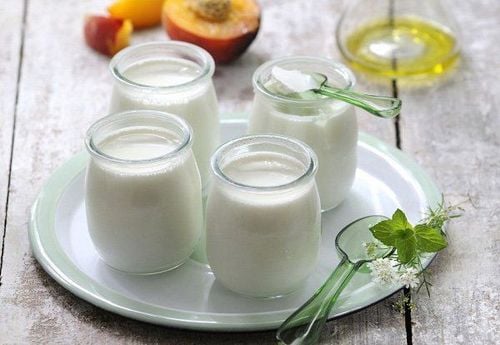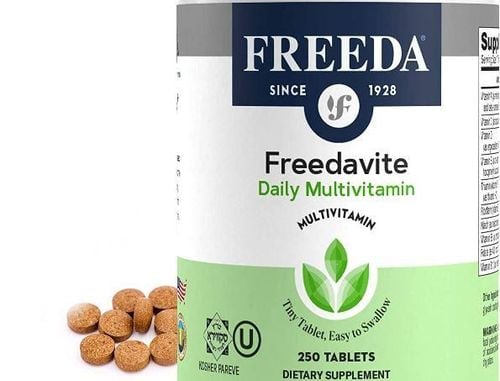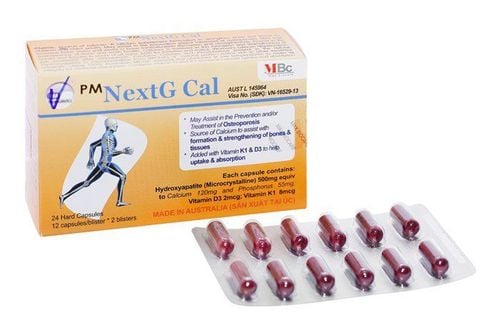This is an automatically translated article.
The article was consulted with Dr. Nguyen Thai Ngoc Chau - Neonatologist - Department of Pediatrics - Neonatology - Vinmec Phu Quoc International General Hospital.Milk and other calcium-rich foods are a must in your child's diet. Calcium is an important component of building strong bones. But most children and teens don't get the recommended 1,300 mg of calcium per day. Young children and infants who do not get enough calcium and vitamin D (which helps absorb calcium) are at higher risk of developing rickets. In addition, calcium also plays an important part in ensuring that muscles and nerves function properly, as well as in the release of hormones and enzymes. So, if blood calcium is low, the body takes calcium from the bones to help with these functions. Therefore, in the daily diet should add enough calcium for the body. In this article, we will provide useful information to help your child get a calcium-rich diet.
1. Calcium in children's diet
1.1. The importance of calcium
During childhood and adolescence, children's bodies use calcium to build strong bones. This is a process that extends and matures towards the end of adolescence. Calcium in bones will begin to decrease in adulthood and bones will gradually decrease in old age. When children get enough calcium and get enough physical activity during childhood and adolescence, they will have strong bones when they reach adulthood.Calcium is essential for the development of healthy bones and teeth, it plays an important role in promoting nerve and muscle function, helping blood clotting and activating enzymes that convert food into energy. About 99% of the body's calcium is concentrated in bones and teeth. Children therefore need a steady supply of calcium during their bone growth to support healthy growth.
1.2. Harm of calcium deficiency
For growing children and adolescents, especially girls, getting enough calcium is important for healthy bones. The diet does not provide enough nutrients for bone development, your child is at risk of osteoporosis and the risk of fractures later in life is also very high.Young children who do not get enough calcium and vitamin D are at high risk of developing rickets. Rickets is a disease that causes bones to soften, grow less, and sometimes cause muscle pain and a feeling of weakness in children.
1.3. Harm of too much calcium in the body
Excessively high levels of calcium in the blood (hypercalcemia) are usually caused by a medical condition and are not related to consuming too much calcium in foods and supplements.as many people still mistakenly believe. The Institute of Medicine recommends that children between the ages of 1 and 8 get no more than 2,500 mg of calcium per day - the equivalent of 8 glasses of milk a day (about 240ml each). While you should monitor how much calcium your child gets from his diet, it's highly unlikely that he'll get too much calcium from food.
However, it is also necessary to mention the problem, calcium supplements are sometimes the cause of an excess of calcium due to a lack of understanding during use, an example of too much calcium supplementation increases risk of kidney stones
Another note, if your child likes to drink a lot of milk, you should be careful not to let him drink too much, causing him to absorb a lot of calories in milk and forget about other healthy foods. In addition, too much calcium will cause constipation.

Dung nạp quá nhiều canxi sẽ gây táo bón cho trẻ
1.4. How much calcium do children need?
From 1 to 3 years old: 700 mg daily From 4 to 8 years old: 1,000 mg daily From 9 to 18 years old: 1300 mg daily (equivalent to 4 cups of milk) But by 12 years old about 1/10 girls and 1/ 3 boys get enough calcium every day. You don't have to worry about getting the recommended amount of calcium for your child each day. Instead, just get average calcium levels over a few days or a week.2. Food rich in calcium for babies
2.1. Milk, cheese and yogurt are always at the top
“Different foods provide different amounts of calcium, but most of us get the most calcium from milk and dairy products,” says Ellie Krieger, a healthy eating expert and mom. from milk. One cup of cow's milk has about 300mg of calcium, which is equivalent to 1 cup of yogurt (207mg), 14 grams of natural cheese or 57 grams of processed cheese.For children 2 years and older, switch to low-fat or skim milk. Whole milk is higher in calcium than flavored milk, but for a change of taste, flavored milk isn't a bad choice either.

Sữa, phô mai và sữa chua đứng đầu danh sách các thực phẩm chứa nhiều canxi
2.2. Soy milk fortified with calcium
If your child cannot take cow's milk. Another option is soy milk, cheese and yogurt. Soy milk without calcium contains only about 10mg of calcium per cup and it is difficult for the body to absorb calcium, but for calcium-fortified soy milk, the calcium content in these preparations is not inferior to cow's milk or milk. sometimes even more. (1 cup of 240ml provides about 500mg of calcium).2.3. Orange juice
When it comes to orange juice, many people will immediately think of the vitamin C content in it, but forget that fortified orange juice can contain 500mg of calcium per cup. However, the calcium content varies with each preparation, so be sure to read the nutrition label carefully before choosing. Keep in mind that the “average % nutritional value” listed on the label based on the needs of adults 50 years and younger is 1,000 mg. Children and teens need 500 to 1,300 mg per day, depending on age. While fortified orange juice is a great way to get calcium, Healthy Eating Expert Krieger also recommends eating fresh oranges, each naturally containing about 50 mg of calcium.2.4. Tofu
To be able to take advantage of the maximum calcium content in tofu requires high processing techniques that not everyone has. Basically tofu made with calcium sulphate contains more calcium than tofu made with magnesium chloride, or nigariKrieger experts recommend using tofu directly or preheating it by pan frying to change the taste.
2.5. Calcium in fish bones
The highest amount of calcium in fish is salmon. One 85-gram serving of pink salmon, along with the bones, provides about 180 mg of calcium, or about two-thirds of the calcium in a cup of milk. Preparing salmon to suit your child's taste is a challenge. A few tips for you: steam salmon with a little dill to eliminate the fishy smell, grind salmon to make fish cakes to change dishes for children...2.6. Almond
Ms. Krieger says almonds contain a significant amount of calcium. A reasonable serving is about 1/3 cup, containing about 110mg of calcium whether they are raw or roasted. Krieger also suggests using almond butter in place of peanut butter in your child's sandwiches or mixing almonds in salads or simply feeding them directly.2.7. Sweet potatoes and potatoes
What few people know is that in one sweet potato provides about 55 mg of calcium, and a cup of cooked sweet potato about 76 mg. In addition, sweet potatoes contain many other nutrients, and it is also easy to increase the calcium index in sweet potatoes by mixing mashed sweet potatoes with yogurt or cheese.A single potato contains only about 19 mg of calcium, not as high as a sweet potato, but there are too many ways to cook it such as stewed potatoes, cheese fries, french fries... Sometimes changing dishes for children to they don't get too bored with the food.

Trong một củ khoai lang cung cấp khoảng 55 mg canxi
2.8. White beans
One cup of white beans, boiled or dried, provides about 130 mg of calcium, almost half a cup of milk. One cup of canned white beans has about 190 mg of calcium. One cup of canned chickpeas, also known as garbanzo beans, contains about 80 mg.calcium. It's also not easy to make them suitable for children, you can try with stews; Crush or puree them or another option is to make a gentle pea soup.2.9. Broccoli
Broccoli contains a significant amount of calcium, but for kids who don't like to eat vegetables, eating about 5 broccoli sprigs (equivalent to the calcium content of a cup of milk) can be a problem. Instead of giving your child boiled broccoli, mix broccoli with other fruits and vegetables into a salad with a little yogurt or mayonnaise.2.10. Green bean
The chickpeas themselves contain about 45 mg of calcium. But not to mention the effects of chickpeas on improving health: Chickpeas contain vitamin K and some studies have shown that the right vitamin K intake can increase bone mineral density and bone strength. Furthermore, chickpeas are an excellent source of vitamin C, vitamin A and protein, and like broccoli, they can be combined with dairy products to boost their calcium dosage.The amount of calcium in foods varies somewhat, depending on the brand, the size of the fruit or vegetable, and other factors. Children may eat more of one food or less of another, depending on their age and taste. As long as you can estimate the nutritional content accordingly, neither too much nor too little.
Fat does not affect calcium content, but high-fat dairy products play an important role in a child's development. Children under 2 need to get half their calories from fat for healthy growth and brain development, so they should only eat whole dairy products. But for children over 2 years old, doctors recommend getting fewer calories from fat, so children should eat low-fat or skim dairy products to maintain a reasonable weight.

Đậu xanh chứa khoảng 45 mg canxi
3. The secret to maximum calcium absorption for children
Some nutritionists believe that many children are falling into a state of deficiency in the amount of calcium needed by the body. This may be partly due to the fact that children drink so much juice and other bottled beverages that they forget to drink milk. Here are some simple steps you can take to make sure your child is getting the calcium he needs:Use milk instead of water when making breakfast cereals, hot cocoa and soups Use condensed milk instead regular milk in recipes - it has twice as much calcium as regular milk. Add yogurt to fruit salads; use nonfat powdered milk to make cake batter, sauces and smoothies; Add cheese to veggies, sauces and mashed potatoes. Buy calcium-fortified juices, breads and cereals. Vitamin D helps the body absorb calcium, so make sure your child gets enough vitamin D - about 600 international units (IU) a day. In the early stages of life, children are very susceptible to health problems, so in addition to maintaining a scientific diet, parents can supplement with lysine, essential micro-minerals and vitamins such as zinc. , chromium, selenium, vitamin B group under the advice of a specialist doctor. Providing enough nutrients to help support digestion, enhance nutrient absorption, improve anorexia, and help children eat well.
If there is a need for consultation and examination with experienced pediatricians at Vinmec. Please make an appointment at the website to be served.
Reference source: babycenter.com, everydayhealth.com














